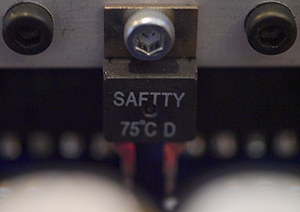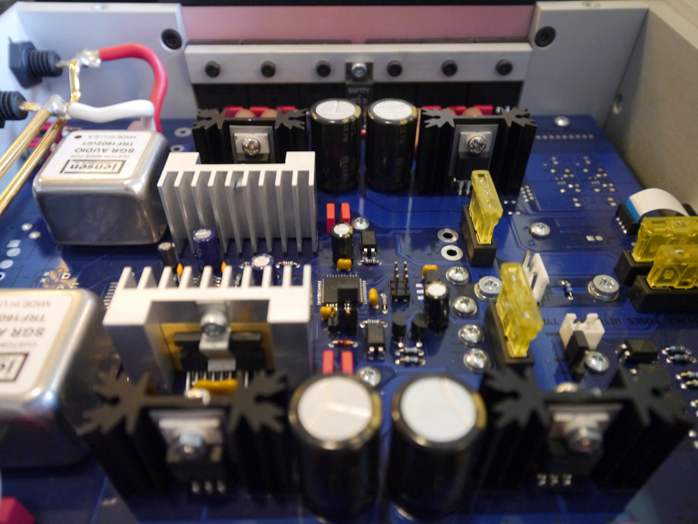This review page is supported in part by the sponsors whose ad banners are displayed below |
 |
 |
|
The thunder from Down Under arrived packed for Mad Max as its steep pricing warranted. Two robust heavily foam-padded flight cases sat cheek to cheek on a pallet reinforced with top and bottom boards, cling wrap around the lot for added moisture protection and strapping. I felt like a bank robber with gold bullion loot.
Though the photos could suggest otherwise, the bristling heat sinks were of the bloodless sort, all edges nicely blunt to not shred your hands. The low-rider footers were less friendly. On floor or shelf I could barely get my fingers beneath the amps for a grip. I'd vote for more space to accommodate sausage fingers.
On the business end appropriately macho biwire terminals hover above four toggles for the stealth mode, VU meter, auto-on and DC protection. There are also indicators for 'fuse blown' and 'over temp'.
A nice touch is the silk screen next to the IEC showing the wired-up voltage rating and fuse value. No need for a frantic owner's manual search on the latter.
Popping the bonnet revealed...
|
|
|
|
 |
|
|
|
|
 |
... an ultra-tidy fully mirror-imaged push/pull layout with massive gold-plated copper bars connecting the paralleled outputs and the absolutely barest/shortest minimum of flying leads. Each radiator-coupled side rail showed off its six ThermalTrak bipolars bolted down for bear with a solid aluminum brace, a 75°C heat sensor between them to trigger protection circuitry during thermal runaway.
Each phase half gets its own Jensen TRF 1602v01 input coupling transformer. Though you might think that turning the amp belly up would gain similar access to the 'dirty' ground floor with its power supply and transformer, not. Hence no photos of the engine room from me. Stuart would provide his own. |
|
|
 |
VU meter off is the proper audiophile mode of operations. Otherwise an annoyingly bright blue bank of lights begins to flicker on the front, go solid when the music hits its particular power level, adds the next row up as volume increases, flickers there, goes solid and so forth. Stealth mode even turns off the blue power button light ring. Whilst SGR Audio clearly has pro roots, these toggles demonstrate how certain stage-show elements can be defeated on demand.
|
 |
|
|
|
With my physical inspection impressed by overall build quality, metal work execution, fit'n'finish and quiet power transformers (little is as offputting as a powerful amp snoring like a breathless obese), the question became, could SGR transcend general preconceptions audiophiles have about companies with pro-audio sensibilities? After all their core business is active speakers. Our lot tends to associate their built-in amps with loads of power, bullet-proof reliability with sophisticated protection circuitry but rather less sophisticated drier flatter sonics.
|
 |
|
 |
  |
 |
|